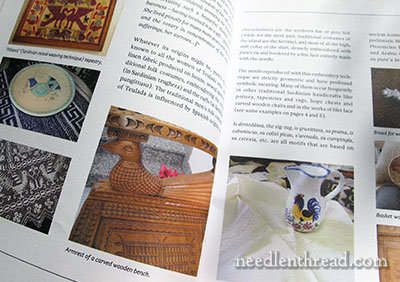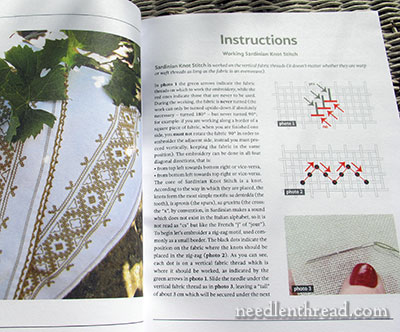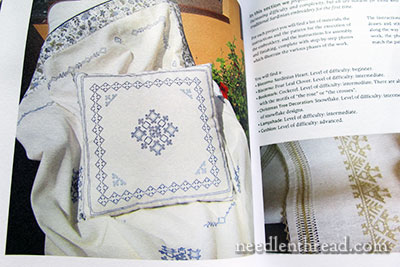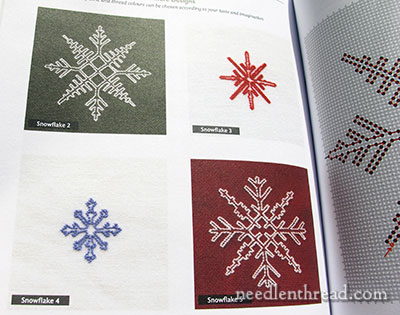This past summer, you might remember that I reviewed Yvette Stanton’s new book, Sardinian Knotted Embroidery.
About the same time that Yvette’s book came out, another book on the same embroidery technique also appeared, called Sardinian Knot Stitch, interpreted by Gioja Ralui.
I love the story of how this book came about! It’s so human, and a lovely tale.
It’s the story of five friends with a passion for Italian needlework who met through an online embroidery group, exchanging tips and ideas. They eventually met up in Italy, and the bonds of true friendship were solidly confirmed.
Sardinian Knot Stitch is a fantastic little book written collaboratively by these five embroiderers – “Gioja Ralui” is a pseudonym constructed from their names. They don’t claim to be professional embroiderers, just friends who love Italian needlework. They collaborated on the book and the projects in it over four years, finally bringing the fruits of their labor to print this past summer.

When Jeanine (who writes the blog Italian Needlework and who is one of the authors) sent me a copy of the book, I knew right away that I would like it.
I know. You’re not supposed to judge a book by its cover. But the simplicity of the cover grabbed me. Because the cover of the book is simple, you really notice this:

It’s an image of one of the fantastic wall murals in Italy, specifically in Sennariolo, in Sardinia. If you’ve never looked up the “talking walls” or “talking houses” that belong to the mural-painting traditions of Italy, you should! They are fantastic!
This illustration is equally wonderful. It relates how firmly rooted needlework is in Italian traditions, threading its way through generations of women. The little granny on the right, no longer stitching but still sitting with the group for a good gossip, looks over her specs at the viewers, inviting them into the circle. Isn’t she great? I love her!
Ok! On to the book!

Sardinian Knot Stitch is made up of an introduction (one of the most pleasant and interesting introductions you’ll probably ever read in a needlework book!), followed by a discussion of materials (there aren’t many materials required in this technique), thorough instructions, a section of border patterns and motif patterns, and finally, a project section.

I have to say something more about the introduction. It isn’t often that a needlework book sports an introduction that reads warmly, like a good chat with a good friend who’s relating little interesting snippets and stories. This intro, while explaining the history of the knotted whitework embroidery of Teulada, does that.
It also touches on the relationship between embroidery and the other local arts and crafts of the area. Often, we tend to think of embroidery as an isolated thing – a little departmentalized craft bubble that exists on its own. “This is my craft. I do embroidery. You do something else for your craft. Neither is related.”
In fact, this isn’t true. Embroidery, like any art, flows from the surrounding culture and traditions of a place and a people. It is interconnected with all the other arts that flow from the same culture. And the introduction in this book illustrates this point.

The materials? 28 count linen, #12 perle cotton, tapestry needles, and scissors. That about covers it!
(Hey, see those scissors up there? Those are these Premax scissors I reviewed a while ago.)

The instructions in the book are very clear and very simple to “get.” They’re made up of a combination of diagrams (to show you where to go with the line of stitching) and step-by-step photos.
I really like the step-by-step photos in this book. It’s a nice way to instruct, and they’re very clear.
When reading through the instructional part of the book, I didn’t feel overwhelmed at all, as if I were dabbling with a technique that is going to be really complicated. The authors approach the technique simply. There’s no muddling up with over-complication.
Once you get the stitch down, and the technique of moving vertically to stitch, and once you understand how to follow the patterns, the rest is simple!

The patterns section of the book is divided into borders and motifs. The borders range from simple (like those above) to much more complex.

An image of a stitched sample accompanies each pattern chart.

Throughout the book, you’ll see photos of beautiful embroidery worked with the Sardinian knot stitch. Notice that it’s not all white-on-white. The stitch adapts itself very well to monochrome embroidery.

In the projects section of the book, you’ll find beginner, intermediate, and advanced projects, in the form of biscornu, bookmarks, Christmas ornaments, a lampshade, and a cushion.
Each project is laid out with materials, charts, and complete instructions and photos for the finish work.

There are four snowflake designs that would work up into nice little ornaments for Christmas.

And this cushion? It’s the advanced project, and it’s gorgeous!

With the more complex designs, the charts are color coded so you can follow the sequence of stitching easily.
In a Nutshell
I really love this little book! I think it’s practically perfect in every respect. I love how it came to be, I love the instructional content, and I love the projects in it.
The quality of the book is a little different – it’s not bad, but it is a print-on-demand book, so don’t expect a glossy finish on the pages.
This Book or That?
To anticipate the question: which book would I recommend, this one or Yvette’s Sardinian Knotted Embroidery, if someone is just buying one book on the technique? I suppose that’s a fair question, but it’s hard to answer!
Both books are excellent for instruction in the Sardinian knot stitch. You’ll learn the same technique from both books. Yvette’s book is a little more expensive, but the quality of the book itself is better (as far as paper, book structure, etc.).
I got more pleasure out of reading Sardinian Knot Stitch by “Gioja Ralui”. It’s really enjoyable to read.
Yvette’s offers a lot of “troubleshooting” in her instructions. She also has a separate pattern page that’s removable. Yvette also goes into more detail on the finished edgings used on this type of whitework.
But if you just want simple, forthright instructions with some enjoyable projects, then this book will do it for you, too.
I’m all for having access to two books on any given technique. When you have two books by two different authors on any one technique, you get a broader vision for the technique. You also learn that there’s more than “one way” in embroidery. There’s room for interpretation.
Where to Find It
Sardinian Knot Stitch is a self-published print-on-demand book, available through the following sources:
In the US, you can find Sardinian Knot Stitch through Amazon.
Worldwide, Sardinian Knot Stitch is available through Book Depository – it takes up to four days or so before it’s shipped.







Dear Mary
Oh how lovely that a group of enthuastic friends of the Sandinian Knot stitch wrote a book together and yes I agree the front cover has got that comfort appeal of times gone by and what a great idea to self publish. The book seems to cover all you need to know on the Sandinian Knot stitch with instructions and projects from beginner to more complicated techniques and you don’t have to spend fortune on materials. Thanks for reviewing the book and sharing your views with us Mary a great resource to have in your library.
Regards Anita Simmance
Think you for another nice review.
I just check the price of the books on Amazone Canada. You said that Yvette Stanton was more expensive than the other and it is the opposite.
Mrs Stanton’s book is 14,63$CAD, while the other is more than twice the price, 33,31$CAD.
*blushing*
I’m thrilled to hear your opinion on the book, it means a *lot* – thank you for the review! Would love to see how(if) you use the stitch in future projects.
It is good to read this review. I purchased the Stanton book when the review appeared on this site. I can do the knot but am having difficulty identifying a type of linen that would make counting easier. I tried 32 ct Belgian linen and cannot see well enough to be accurate in counting. I tried Danish linen used for Hedebo and it works. Will also try 28ct Permin as it has fine linen threads and it is easier to work over one thread as required by this technique. It is such a beautiful technique! Thanks for highlighting these 2 books, Mary.
Marion, I would recommend starting out on 28 ct cotton evenweave. Something like Monaco, Sonoma or even Linda. Failing this, if you’ve got some old Jubilee (it’s my favourite!) or even Lugana. Try to get cotton instead of synthetics because the knots slip on rayon!
The cover of the book that you reviewed with this weekend’s article brought back so many memories. I was fortunate enough to spend two years in a small village in Italy, initially going there without being able to even speak the language. Rather quickly I found a small ahop in the town that sold embroidery floss and nice linen fabrics. The ladies of the village quickly pulled me into their circle, teaching me their language as well as their way of stitching. (They also taught me how to cook real Italian meals!)
A good part of most afternoons were spent stitching together, along with the flow of gossip!
*Sigh* Sounds lovely, PJ!! Thanks for that vision! 🙂
*sigh* That sounds positively splendid! I bet you had a grand time.
A few years ago I had a holiday in Sardinia. There is an absolutely wonderful museum of culture which features a lot of garments and other textile items – you can see examples of the embroidery on many of them. I highly recommend it if ever you have the chance to visit.
Are you talking about the Museo Etnografico in Nuoro? It is wonderful!